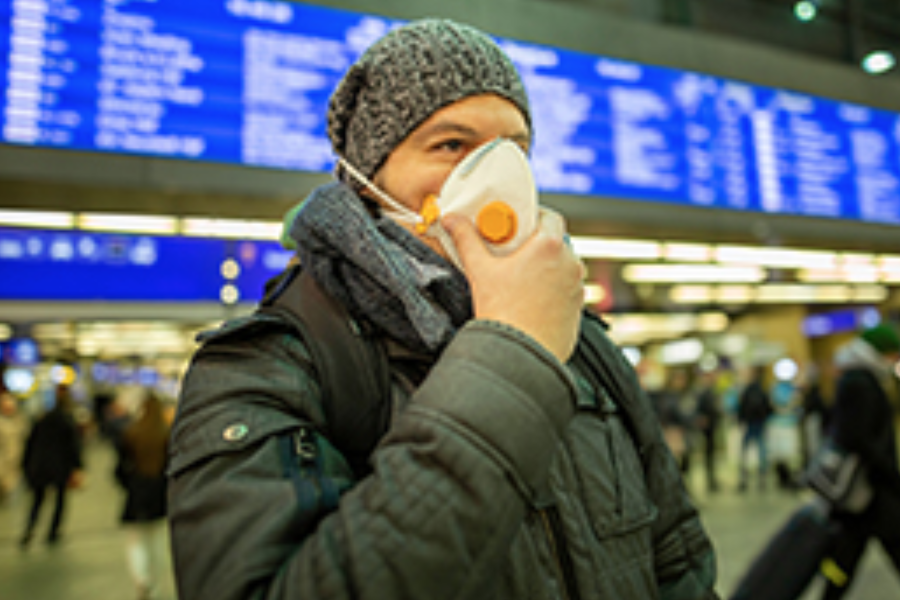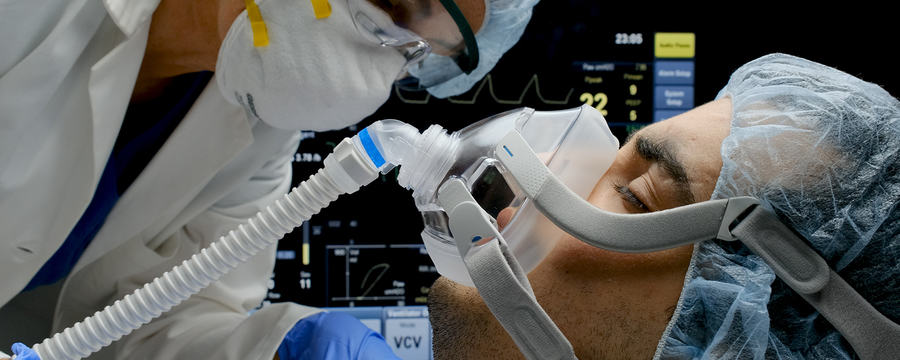Do Face Masks Protect?

Share this step
Should members of the public wear face masks?
Face masks could be one possible way to reduce the reproduction number R but whether or not the general public should wear face masks is a controversial issue. The question is confused because
- there are different kinds of face masks – clinical and others
- the benefits can be for the wearer of the mask or others
- stocks could be taken away from front line workers
- there no definitive study showing clear benefits
For the purpose of this discussion it will be assumed that the question is whether or not members of the public should wear ‘non-clinical’ face masks. This includes simple masks produced commercially and do-it-yourself masks made of cloth and elastic bands.
The consensus is that these masks provide little or no protection to the individual. It is said that these masks cannot protect uninfected people from the fine droplets that can travel up to two metres when an infected person coughs or sneezes. This is because the aerosol droplets have a diameter less than the mesh of the fabric, and some may get through.
The www.healtheuropa.eu website says that
Coughing and sneezing produce a “muzzle velocity” of 50 m/second (for sneezing) or 10 m/s (for coughing), rendering the two-m protection zone of little assistance without an additional barrier in the form of a mask.
If you have cough, fever and difficulty breathing you should wear a mask and seek medical care. If you do not have these symptoms you do not have to wear masks because there is no evidence that they protect people who are not sick.
However, if you are healthy but you are taking care of a person who may be infected with the new coronavirus then you should wear a mask whenever you are in the same room as that person. And remember, if you choose to wear a mask use it and discard it properly and clean your hands with alcohol hand rub or soap and water.
Before putting on a mask, clean hands with alcohol-based hand rub or soap and water. Cover mouth and nose with mask and make sure there are no gaps between your face and the mask. Avoid touching the mask while using it; if you do, clean your hands with alcohol-based hand rub or soap and water. Replace the mask with a new one as soon as it is damp and do not re-use single-use masks. If you wear a mask, then you must know how to use it and dispose of it properly. [2]
Update 8th May 2020
Asymptomatic (including presymptomatic) infected individuals are infectious. Without mitigation, the current estimate is that 40%-80% of infections occur from individuals without symptoms. Universal screening of asymptomatic SARS-COV2 in women admitted for delivery in New York City shows that 13.7% were infected, and that asymptomatic women accounted for 88% of infected individuals in the study. Of individuals who do become symptomatic, viral loads are the highest in the presymptomatic and early symptomatic phase, decreasing thereafter.
Respiratory droplets from infected individuals are a major mode of transmission. This understanding is the basis of the recommendations for physical distancing, and of the PPE guidance for healthcare workers14. Droplets do not only come from coughing or sneezing: in a-/pre-symptomatic individuals, droplets are generated via talking and breathing.
Face masks reduce droplet dispersal. Cloth-based face masks reduce emission of particles by variable amounts, for example Anfinrud et al showed that they are almost completely eliminated. Davies et a_l showed that cloth masks filtered viral particles during coughing at about 50 to 100% of the filtration efficiency of surgical masks, depending on fabric, with absolute filtration efficiencies of 50-70%, and about 70-80% for oral bacteria. van der Sande _et al showed 50% filtering efficiency for airborne particles.
This evidence supports the conclusion that more widespread risk-based face mask adoption can help to control the Covid-19 epidemic by reducing the shedding of droplets into the environment from asymptomatic individuals. This is also consistent with the experiences of countries that have adopted this strategy. [3]
Update 17th May 2020
Update 13th June 2020
Face Masks Considerably Reduce COVID-19 Cases in Germany: A Synthetic Control Method Approach
We use the synthetic control method to analyze the effect of face masks on the spread of Covid-19 in Germany. Our identification approach exploits regional variation in the point in time when face masks became compulsory. Depending on the region we analyse, we find that face masks reduced the cumulative number of registered Covid-19 cases between 2.3% and 13% over a period of 10 days after they became compulsory. Assessing the credibility of the various estimates, we conclude that face masks reduce the daily growth rate of reported infections by around 40% [5]. With thanks to Geraint Johnes.
References
[1] Stephanie Price, ‘Are face masks useful for stopping the spread of COVID-19?’, Health Europa, 3rd April 2020. https://www.healtheuropa.eu/are-face-masks-useful-for-stopping-the-spread-of-covid-19/99087/
[2] WHO. Advice on the use of masks in the context of COVID-19 5 Feb 2020, viewed 29 April 2020, https://www.who.int/emergencies/diseases/novel-coronavirus-2019/advice-for-public/when-and-how-to-use-masks
[3] Royal Society DELVE Initiative, ‘Face Masks for the General Public’, AboutPeopleReports, May 4, 2020. An earlier version of this document was communicated to SAGE in April 2020. https://rs-delve.github.io/reports/2020/05/04/face-masks-for-the-general-public.html
[4] Philip Anfinrud, Valentyn Stadnytskyi, Christina E. Bax, Adriaan Bax, ‘Visualizing Speech-Generated Oral Fluid Droplets with Laser Light Scattering’, New England Journal of Medicine, April 15, 2020 https://www.nejm.org/doi/full/10.1056/NEJMc2007800
[5] Timo Mitze, Reinhold Kosfeld, Johannes Rode, Klaus Wälde, ‘Face Masks Considerably Reduce COVID-19 Cases in Germany: A Synthetic Control Method Approach’, Gutenberg School of Management and Economics Johannes Gutenberg Universität Mainz, IZA DP No. 13319, June 2020 http://ftp.iza.org/dp13319.pdf
Share this
COVID-19: Pandemics, Modelling, and Policy


Reach your personal and professional goals
Unlock access to hundreds of expert online courses and degrees from top universities and educators to gain accredited qualifications and professional CV-building certificates.
Join over 18 million learners to launch, switch or build upon your career, all at your own pace, across a wide range of topic areas.
Register to receive updates
-
Create an account to receive our newsletter, course recommendations and promotions.
Register for free







